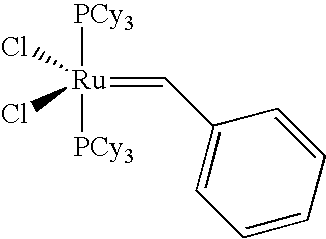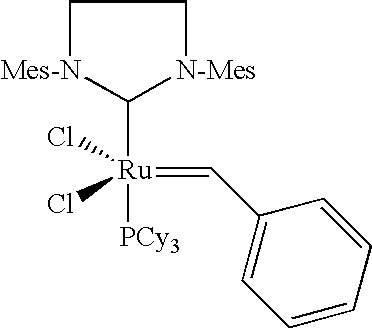Catalyst systems and their use for metathesis reactions
a catalyst system and catalytic technology, applied in the field of catalytic systems for metathesis reactions, can solve the problems of severe restrictions on the processing ability of hnbr, inability to achieve, and inability to achieve, so as to achieve narrow molecular weight distribution, reduce the molecular weight, and increase the activity of metathesis catalysts
- Summary
- Abstract
- Description
- Claims
- Application Information
AI Technical Summary
Benefits of technology
Problems solved by technology
Method used
Image
Examples
examples
[0271]The following catalysts were used:
“Grubbs II Catalyst” (MW: 848.33 g / mol)
[0272]The Grubbs II catalyst was procured from Materia (Pasadena / Calif.).
“Hoveyda Catalyst” (MW: 626.14 g / mol)
[0273]The Hoveyda catalyst was procured from Aldrich under the product number 569755.
“Grela Catalyst” (MW: 617.13 g / mol)
[0274]The Grela catalyst was prepared by the method published in J. Org. Chem. 2004, 69, 6894-6896.
General Method for the Metathetic Degradation of Nitrile Rubber (“NBR”)
[0275]The degradation reactions described in the series of experiments 1 to 5 below were carried out using the nitrile rubber Perbunan® NT 3435 from Lanxess Deutschland GmbH. This nitrile rubber had the following characteristic properties:
Acrylonitrile content: 34% by weight
Mooney viscosity (ML 1+4 @ 100° C.): 31 Mooney units
Residual moisture content: 1.2% by weight
Mw: 186.832 g / mol
Mn: 60 000 g / mol
PDI (Mw / Mn): 3.1
[0276]The metathetic degradation was in each case carried out using 293.3 g of chlorobenzene (hereina...
PUM
| Property | Measurement | Unit |
|---|---|---|
| weight ratio | aaaaa | aaaaa |
| molecular weight distribution | aaaaa | aaaaa |
| polydispersity index PDI | aaaaa | aaaaa |
Abstract
Description
Claims
Application Information
 Login to View More
Login to View More - R&D
- Intellectual Property
- Life Sciences
- Materials
- Tech Scout
- Unparalleled Data Quality
- Higher Quality Content
- 60% Fewer Hallucinations
Browse by: Latest US Patents, China's latest patents, Technical Efficacy Thesaurus, Application Domain, Technology Topic, Popular Technical Reports.
© 2025 PatSnap. All rights reserved.Legal|Privacy policy|Modern Slavery Act Transparency Statement|Sitemap|About US| Contact US: help@patsnap.com



